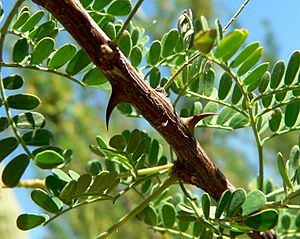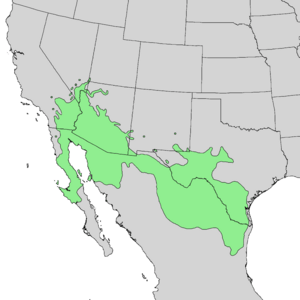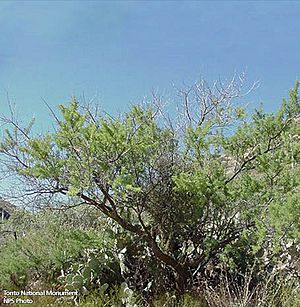Senegalia greggii facts for kids
Quick facts for kids Senegalia greggii |
|
|---|---|
 |
|
| Conservation status | |
| Scientific classification | |
| Genus: |
Senegalia
|
| Species: |
greggii
|
| Varieties | |
|
|
 |
|
| S. greggii var. greggii natural range | |
 |
|
| S. greggii var. wrightii natural range | |
Senegalia greggii, also known as Acacia greggii, is a type of tree or large bush. It grows naturally in the southwestern United States and northern Mexico. You can find it from southern Utah all the way down to Baja California and other parts of Mexico. The trees in Utah are the most northern Senegalia species found anywhere in the world!
People call this plant by many names, like catclaw acacia or wait-a-minute bush. These names come from its sharp, hooked thorns that look like a cat's claws. If you walk past, these thorns can easily catch onto your clothes or skin. You'll have to "wait a minute" to carefully remove them so you don't get hurt or rip your clothes! The scientific name greggii honors Josiah Gregg, an explorer and naturalist from the 1800s.
Contents
What Senegalia greggii Looks Like
This plant can be a large bush or a small tree. It usually grows about 10 to 15 meters (33 to 49 feet) tall. Its trunk can be up to 20 to 30 centimeters (8 to 12 inches) wide. The leaves are a grayish-green color and fall off each year.
The leaves are made up of smaller parts called leaflets. These leaflets are arranged in 1 to 3 pairs. Each part is about 2 to 3 centimeters (0.8 to 1.2 inches) long. There are 10 to 18 tiny leaflets on each part, each about 3 to 6 millimeters (0.12 to 0.24 inches) long.
Flowers and Fruit
The flowers grow in thick, cylinder-shaped clusters. Each flower has five small, cream-colored petals. They also have many creamy yellow stamens, which are the parts that hold pollen. The fruit is a flat, twisted pod, like a bean pod. It's about 6 to 15 centimeters (2.4 to 5.9 inches) long.
Inside the pod, there are usually 3 to 5 hard, flat, brown seeds. The pod gets narrower between each seed. When the seeds are ready, the pod can open up to release them. It can also break apart at the narrow spots.
How Senegalia greggii Lives
Senegalia greggii often grows in dry streambeds called arroyos. This is because its roots can reach deep water there. Its seeds need a special process called scarification to sprout. This means the hard outer shell of the seed must be scratched or broken.
This scratching often happens during flash floods. The floods disturb the ground and bring enough water for young plants to grow deep roots. This helps them survive the dry season. The catclaw tree loses its leaves for most of the year when it's dry.
Plant Partnerships
Senegalia greggii has special glands that produce nectar, a sweet liquid. These are called extrafloral nectaries. Ants are known to eat and drink from these glands. In return, the ants might help protect the plant from insects that try to eat its leaves. This is a type of helpful partnership called mutualism.
Like other trees in dry streambeds, S. greggii often gets a plant called Desert mistletoe growing on it. Unlike many other bean plants, S. greggii does not seem to work with special bacteria in its roots to get nitrogen from the air.
Seed Spreading
Scientists think this plant might be an example of an "evolutionary anachronism". This means its way of spreading seeds might have worked better in the past. Long ago, large mammals like mammoths might have eaten the fruit. Their chewing and digestion would have scratched the seeds, helping them sprout. Then, the animals would have dropped the seeds far from the parent tree.
Today, animals like Gambel quail eat the seeds. Antelope also eat the leaves, but they are careful because of the thorns!
How People Used Senegalia greggii
Even though Senegalia greggii is used as food for farm animals, its mature seeds can be harmful if not prepared correctly. Native American tribes in the desert, like the Chemehuevi, Pima, and Cahuilla, knew this. They would gather and eat the young, unripe beans.
The Cahuilla people would grind the dried beans into a mush or cakes. The Havasupai ground the beans into flour to make bread. The Seri ground the beans into a meal and mixed it with water and sea lion oil to make a type of porridge. The Kumeyaay used S. greggii as food for their animals.
Other Uses
The Pima and Tohono Oʼodham people ate the seeds as a type of roasted flour called pinole. The Cahuilla and Pima tribes used the plant's strong fibers for building materials and for firewood. The Havasupai split the twigs to make baskets. They also used the twigs as a broom to clean grinding stones.
The O'odham people used broken twigs to make intricate weaves in their baskets. The Pima used dried bushes to build brush fences. The branches were also used to make frames for baby cradles. The Tohono O'odham used the branches to make disguises for deer hunters. Women would dry the buds and blossoms to make perfume sachets. The sticks were also used to knock down saguaro fruits from cacti. Curved rods from the plant were used to clean animal skins. The Akimel O'odham made bows from the wood.
Gallery
See also
 In Spanish: Acacia greggii para niños
In Spanish: Acacia greggii para niños








